Lion’s Head Pork Meatballs (Lion’s head meatballs) is a highly regarded Chinese cuisine that catches everyone’s attention because of its size. It measures up to 1.5 to 2 inches in diameter, juicy, fluffy, and served with an umami-packed gravy.
It is different because the pork meatballs are stewed in a braising liquid, instead of the conventional method like boiling or baking.
Lion’s Head Meatballs (狮子头, pronounced as shizitou) is made with minced pork and often added some chopped water chestnuts or lotus root to make it less compact. There are several ways to make it, which ranges from stewing for a few hours to only simmer for half an hour. I have simplified the preparation by reducing the time required and pan-fried instead of deep-frying before stewing.
It is not the most authentic method, but it saves time and is also healthier. I will also mention some popular variations of the recipe that you can adopt should you wish to make some changes.
Let’s get started.
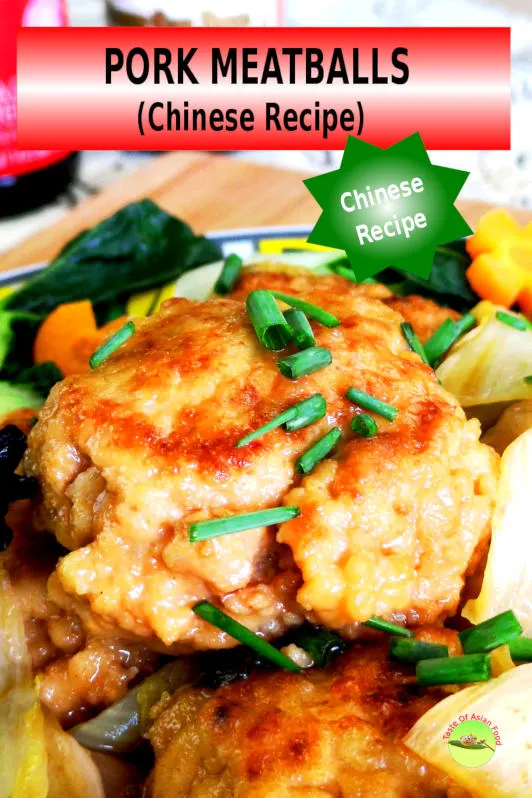
Use minced pork with some fat
The pork should have a mixture of lean meat and fat. The best ratio is sixty percent lean meat and forty percent fat, but it is not necessary to follow strictly. However, both are important as lean meat has more flavor, and the fats give a melt-in-the-mouth feeling. I am using pork belly, which is ideal as it has one-third of fat. You can reduce the fat to a quarter if you wish.
The best way to prep the pork is to cut the fat and mince the lean meat separately.
- Cut the lean meat into small pieces, then mince it finely. Mincing is essential to break down the meat into a paste instead of remains as small pieces. Finely minced pork has a different mouthfeel than cut pork.
- As for the fat, it is difficult to cut it into small pieces small if you mince it with the lean pork directly. Therefore, I always cut the fat into the size of rice grains first before combining them with lean meat. The fat will embed in the meat paste and melt in your mouth while you eat it.
Flavor the pork with ginger and scallions
Ginger and scallion provide the essential flavor for lion’s head pork meatballs.
The authentic method involves cutting them into small pieces, or coarsely grind with a mortar and pestle, then add some hot water to extract the flavor. Add the extract to the minced meat to increase the flavor and moisture of the meatballs.
You can also add the finely minced scallions and ginger, as that is only a guideline rather than a rule.
My preference is to prepare the ginger and scallion water so that there are no noticeable pieces of scallion and ginger embedded inside the meatballs.
Add some water chestnuts or lotus root. Why?
It is customary to add some coarsely chopped water chestnuts to the minced pork. There are two reasons to do that. First, the water chestnuts loosen up the compact minced pork to achieve a super fluffy texture. Secondly, water chestnuts impart its texture and flavor to the patty.
If you do not have water chestnuts, you can use coarsely chopped lotus roots as the replacement. It will result in a similar texture like water chestnuts.
Another alternative is to add some tofu. I am not in favor of tofu because it does not have a crunchy mouthfeel like the water chestnuts or lotus roots. Instead, you can substitute it with chopped onions or add some bread crumbs into the minced pork.
Season the pork meatballs
Light soy sauce and Chinese rice wine are the main seasonings in the recipe, besides ginger and scallions.
You also need eggs, which add flavor and help to bine the minced pork together.
Besides that, season the minced pork with some salt, sugar, white pepper, and sesame oil.
Secret technique – slam the minced meat against the bowl!
I did not make mistakes here. Slam the minced meat against the bowl!
This technique is unique in Chinese cuisine. Many western-style recipes may suggest mixing all the ingredients until they bind together. I have read some even said that do not over mix.
However, Lion’s head Chinese style pork meatballs do require to mix at least up to 5 minutes or more.
Let me explain.
The texture of the lion head pork meatballs should be spriggy. Slam the meat paste against the bowl works well to get this texture.
Here are the steps to make springy pork meatballs
- Put all the ingredients into a large mixing bowl.
- Stir the mixture with a pair of chopsticks or a metal spoon in one direction. This process will breakdown the protein of the pork and restructure to form a sticky mass, which is springy.
- Keep mixing until there are streaks of meat paste sticks at the side of the bowl.
- Now pick up the meat and slam against the bowl. This method can increase the springiness further of the meat. Eventually, it will form a sticky mass. (Please refer to the embedded video for details).
The result of prolonged mixing and slamming will not only transform the minced pork into a springy texture, but it will also make the meat disintegrate partially, which results in meatballs having a melt in the mouth feeling after stewing for a few hours.
Note: This ‘slamming’ method is also used in other Asian cooking to make the meat springy. You can refer to the Shumai recipe which applies the same method used to prepare the meat paste.
Why does the lion’s head meatballs need to cook twice?
The lion’s head pork meatballs have a high content of moisture. While this is the way to ensure they are soft and tender, it also poses a problem to bind the ingredients together. That is why I have to pre-cook the meatballs to avoid them from breaking apart during prolonged stewing.
There are a few ways to pre-cook the meatballs.
- The most common method is to deep-fried the meatballs. This method involves plenty of oil, which may not be the most practical way to do it at home.
- The second method is to blanch the meatballs in boiling water for three minutes or until the surface is cooked.
- The third method which I use in this recipe is to pan-fry the meatballs with a non-stick pan. This method is simple and requires minimal oil. The only downside is the pork meatballs will be flattened a bit during pan-frying.
All these methods will firm up the meatballs and keep them in shape during stewing. It does not matter if the inner part of the meatballs are still raw since they will be cooked again for the second time.
Prepare the braising liquid
The braising liquid is similar to the recipe for braising the tea eggs and soy sauce chicken. The main ingredients are rock sugar, light soy sauce, Chinese rice wine, garlic, and scallion. You can add some bay leaves and star anise to enhance the flavor.
If you have the leftover braising liquid from making tea eggs or soy sauce chicken, you can use that to braise the pork meatballs instead of preparing it again.
Stew Lion’s head meatballs for forty minutes (or up to four hours)
- Place all the ingredients for the braising liquid in a pot. Line the base with scallions.
- Arrange the meatballs on top of the scallions.
- Insert pieces of napa cabbage in between the meatballs.
- Cover the meatballs with more napa cabbage pieces.
- Stew the meatballs for 30 minutes or up to 4 hours.
If you like cabbage, here is another cabbage recipe which I have written recently. It is a quick and easy stir-fry cabbage recipe with dried shrimp and garlic. Another one is the Chinese style cabbage rolls that I have stopped making for years, which I pick up again recently.
There are different opinions about the duration required to stew the meatballs. In theory, the meatballs will be cooked in 20 minutes. However, some authentic recipe suggests stewing the meatballs up to 3 to 4 hours.
I only stewed meatballs for 30 minutes in this recipe for simplicity. As for comparison, I also make another batch, and stew for 4 hours.
The result:
- After stewing for 30 minutes, the meatballs are cooked, tender, and soft. The chopped water chestnuts are still intact, and still crunchy.
- After stirring for 4 hours, the texture of the meatballs has changed. It is now become much softer and has a melt in the mouthfeel. I can’t taste the water chestnuts anymore, as it has entirely disintegrated. The meatballs also absorb too much braising liquid and are too salty.
Verdict:
It depends on which version of the lion’s head pork meatballs you want to make. I prefer the quick method as I want to taste the water chestnuts, although it may not be truly authentic. If you prefer the prolonged stewing method, reduce the amount of light soy sauce in the braising liquid to make it less salty.
To serve
You can serve the meatballs individually in a small bowl. Place the cabbage alongside and ladle the stewing liquid onto the meatball. Garnish with chopped scallions. You can also serve the meatballs on a large plate and share it with everyone.
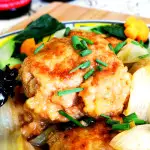
Pork meatballs - How to make Asian Lion's head meatballs
Quick and easy ways to make the Chinese pork meatballs (Lion's head meatballs / 狮子头) at home. Mouthwatering, even for the banquet!
Ingredients
For the meatballs: (A)
- 500g pork belly
- 1 tsp salt
- 1 tsp sugar
- 1/2 tsp ground white pepper
- 1 tbsp rice wine
- 1 tbsp light soy sauce
- 2 eggs
- 2 water chestnuts
- 30g cornstarch
- 2 tbsp ginger scallions juice (make with 20g ginger + 2 stalks of scallions)
For the braising liquid: (B)
- 20g rock sugar
- 4 tbsp light soy sauce
- 2 bay leaves
- 1 star anise
- 3 tbsp rice wine
- 2 clove garlic
- 1 stalk scallion
- 200ml water
Others: (C)
- napa cabbage (enough to cover and separate the meatballs)
- cornstarch to coat the meatballs
- cooking oil for pan-frying
- chopped scallions to garnish
Instructions
- Cut the fat into small pieces (size of rice grain).
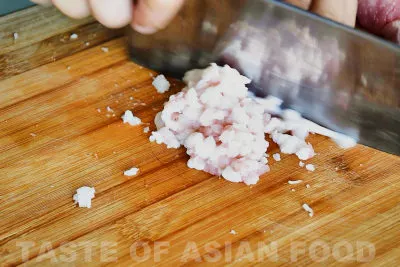
- Mince the lean meat separately.
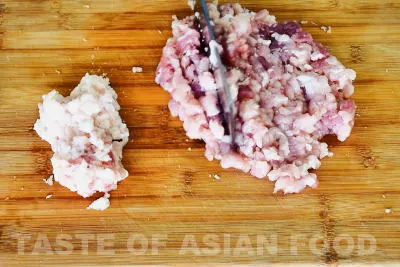
- Coarsely cut the ginger and scallions, then add some hot water to let it steep for ten minutes. Discard the ginger and scallions and use only the extract.
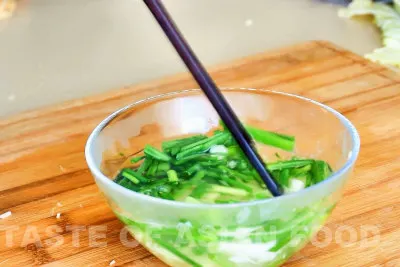
- Mix all the ingredients in A. Slam the meat paste against the bowl until it is well combined into a springy paste.
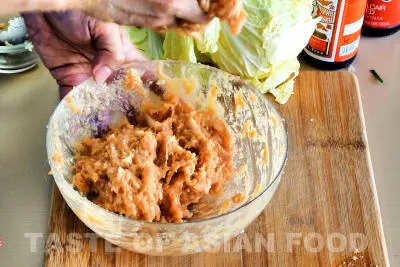
- Shape the meat paste into meatballs, about 80g each. Coat them with some cornstarch. Pan-fry the meatballs until they hole in shape and slightly brown.
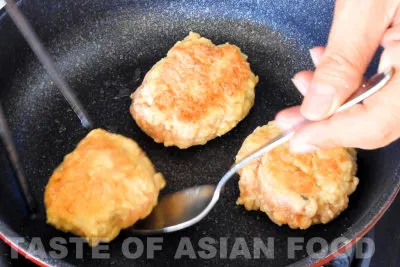
- Add ingredients B in a pot.
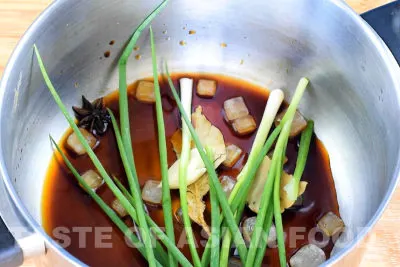
- Arrange the meatballs, single layer.
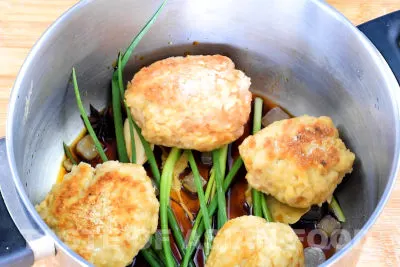
- Use the cabbage to separate the meatballs and cover them completely.
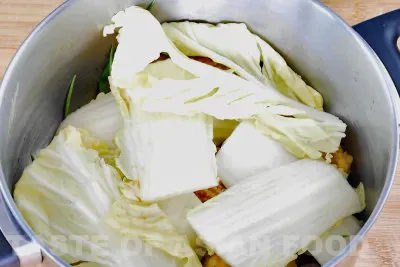
- Stew the meatballs for 40 minutes over low heat. Serve.
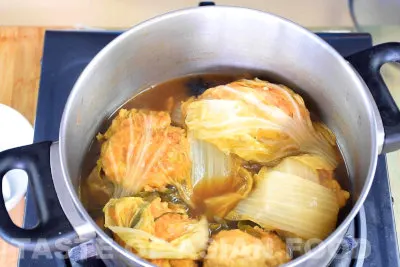
Recommended Products
As an Amazon Associate and member of other affiliate programs, I earn from qualifying purchases.
-
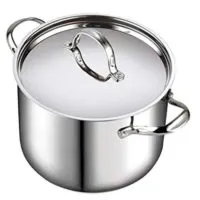 Cooks Standard 02520 Quart Classic Stainless Steel Stockpot with Lid, 12-QT, Silver
Cooks Standard 02520 Quart Classic Stainless Steel Stockpot with Lid, 12-QT, Silver -
 Lee Kum Kee Premium Light Soy Sauce - 150ml (5.27 fl oz)
Lee Kum Kee Premium Light Soy Sauce - 150ml (5.27 fl oz) -
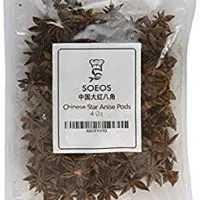 Soeos Star Anise Seeds (Anis Estrella), Whole Chinese Star Anise Pods, Dried Anise Star Spice, 4 oz.
Soeos Star Anise Seeds (Anis Estrella), Whole Chinese Star Anise Pods, Dried Anise Star Spice, 4 oz. -
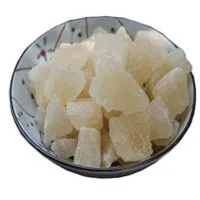 Helen Ou @ Guangxi Specialty: Traditional Pure Brown Rock Sugar 17.6oz
Helen Ou @ Guangxi Specialty: Traditional Pure Brown Rock Sugar 17.6oz
Nutrition Information:
Yield: 6 Serving Size: 1Amount Per Serving: Calories: 533Total Fat: 26gSaturated Fat: 9gTrans Fat: 0gUnsaturated Fat: 16gCholesterol: 144mgSodium: 1581mgCarbohydrates: 44gFiber: 3gSugar: 11gProtein: 27g
This data was provided and calculated by Nutritionix on 3/29/2020

Chinese cabbage soup with meatballs- Easy Asian recipe
Friday 9th of August 2024
[…] pork balls are loosely based on the lion head pork balls 狮子头 recipe I posted earlier. They are made with minced meat and some fat to make them tender. You can […]
Jen Tang
Thursday 2nd of April 2020
Great recipes and techniques! One of the best I've seen! Instructions are clear and precise.
KP Kwan
Thursday 2nd of April 2020
Hi Jen, Thank you for trying the recipe, and have a great day. KP Kwan
Confused
Monday 30th of March 2020
Lion's head meatballs
Could you please explain how, where and when the garlic is used. It's mentioned in some parts of your article but not in the ingredients list.
KP Kwan
Tuesday 31st of March 2020
Hi, Thank you so much for highlighting the error in the text. I have just made the correction. Scallion and ginger are used for making the meatballs, not garlic and ginger as I wrote, which I have corrected in the text. However, garlic is used for the braising liquid. Thanks, KP Kwan
Kevin
Monday 30th of March 2020
Hi KP, Thanks for this easy recipe. I reckon the 30 minutes stewing is good enough, moreover, I have some leftover stewing/braising sauce which I could use it to enhance its flavor further.
KP Kwan
Monday 30th of March 2020
Hi Kevin, Make use of the braising sauce, which I think must be wonderfully flavored. That also saves you time to prepare it. KP Kwan
Jo Everest
Sunday 29th of March 2020
I make a different version but will be definitely trying this version as quicker.
Jo
KP Kwan
Sunday 29th of March 2020
Hi Jo, There are many versions. I hope you will like this one too. KP Kwan